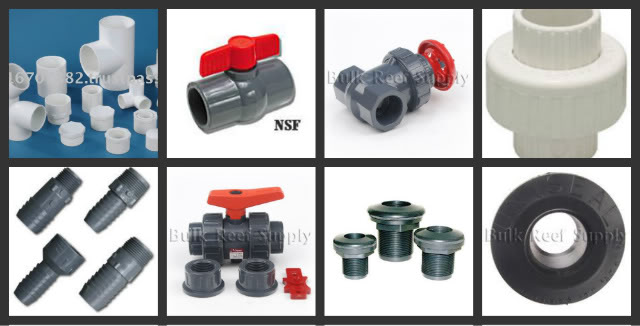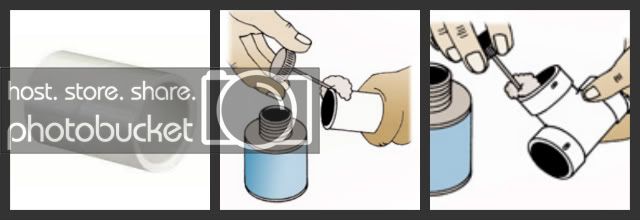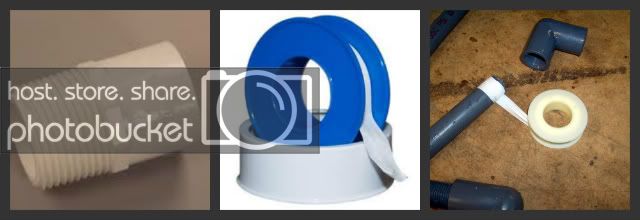With all the different options, decisions related to plumbing an aquarium can be tricky. There are different fittings, piping, sealants, and glues which all have their specific purpose. Depending on the use, each has advantages and disadvantages for application to the aquarium build. This article will cover some of the different types of plumbing as well as the pros and cons of each to assist in making plumbing decisions easier.
Piping
Schedule 40, or SCH 40 for short, is the standard white, rigid piping generally used for household plumbing. It comes in a wide array of sizes and can be purchased in various lengths at most hardware stores. This is generally the inexpensive option when using rigid plumbing but some feel the white pipe with lettering on it is unattractive. It can be painted, but that adds an additional step to the plumbing build.
Schedule 80, or SCH 80 for short, is the grey rigid piping. It is used in higher pressure applications, underground, or where code specifically states SCH 80 must be used due to the higher wall thickness of the pipe. Many use SCH 80 piping due to aesthetics of the grey finish. Unfortunately because it is a higher pressure pipe, it is also more expensive to use. Also the inner diameter of the pipe is smaller which can cause restriction of the plumbing.
Nylon or vinyl tubing is the clear or reinforced flexible tubing which can be found at many hardware stores, and is usually installed using hose barbs and clamps. A benefit to using flexible tubing is the ability to move tubes out of the way, allowing the builder to be a little less exact because the tubes bend. It can also assist in lessening pump vibration noise. Unfortunately it can kink if it has to bend around corners too tightly. Also the use of hose barbs can restrict flow and cause objects such as snails to get trapped in the tube. Although the clear tubing can be nice to see the flow of water, it can cause algae growth inside the tube which can restrict flow.
SpaFlex is a flexible PVC pipe typically used for spa and pool applications. It can bond with standard PVC fittings and comes in numerous sizes. It is typically white in color and although it is flexible, it is not as flexible as the vinyl tubing. It offers the same benefit of reduction of pump vibration and allows the installer to be a little less exact than hard plumbing. Sourcing SpaFlex is a little more difficult, especially in the larger sizes. A trip to the local spa store is usually in order to find the right size.

Fittings
There are many different standard fittings like 90 degree and 45 degree elbows, Ts, caps, couplers, and bushings which can be used to join PVC pipe. These are all rigid fittings and come in both slip (glue) and threaded joints. They are used to change the flow direction or pattern of rigid PVC. SCH 40 and SCH 80 pipes and fittings are typically universal between the two types. One fitting to try avoid if possible is the 90 degree elbow as it can restrict the flow as water flows around the corner. Use a sweep elbow or two 45 degree elbows instead. Below are some of the more useful fittings that some people miss.
Ball valves can be used to turn the flow of water on and off. They can also be used to control the flow of water when closed part way. By installing ball valved an aquarist is able to shut down a section of the system without disturbing the rest for maintenance. Not all ball valves are created equal and you typically get what you pay for in the long run. The cheaper ones are harder to turn after they are in the harsh saltwater environment for awhile due to the calcium deposits. Typically the SCH 80 ball valves are built with higher quality.
Gate valves can serve the same purpose as ball valves. The difference between the two is instead of using a spinning ball to shut off the flow of water, a gate valve uses a flat piece of plastic to cover the flow. A gate valve will allow for more precise flow control by allowing the handle to turn multiple times before fully closing down the flow of water. These are typically used for modding skimmer outputs, controlling drain noise, or precise reactor flow control. They are more expensive than ball valves but are much more precise where precision is needed.
Unions are a fitting that allows the plumbing to be disconnected easily. These should be installed at any point where removal of plumbing would need to be done. They are great for connections to pumps, reactors, and other equipment. Adding one to each end of rigid plumbing will allow the pipe to be removed for clearing of jammed objects like snails, easy modification of plumbing or for routine cleaning. Some ball and gate valves come with unions already installed for easy maintenance of the valve. They do add to the cost of the plumbing part of the build, but are well worth the extra investment.
Bulkheads are used to create a seal on a flat surface such as an aquarium. The plumbing is connected to the external part of the bulkhead via a threaded, slip or barb connection. These come in ABS plastic for light duty or SCH 80 PVC for a more heave duty connection. They will not create a good seal on a curved surface such as a water holding barrel. Uniseals are available for curved surfaces and provide a good seal.

Connections
There are a few different types of connections when working with plumbing. Some require gluing while others require a clamp to create a seal. If these connections are not installed correctly they can leak or fall apart. Care needs to be taken to ensure a good fit and joint is made with the connections. Some of the more common ones are described below.
Glued connections are usually called “slip†connections in PVC terms. These require the use of a glue which actually fuses the two pieces of plastic pipe together creating a seal. This method is a one shot connection so be sure to measure twice and cut once or you’ll end up wasting pipe and fittings. To glue the fitting first add some PVC primer to the outside of the pipe and the inside of the fitting. This primer cleans and softens the plastic allowing for a better glue joint. Then spread the glue on the primed areas, insert the pipe all the way and give it a 1/4 turn to spread the glue inside the joint. Wipe up the excess and you’re done! SpaFlex requires a special glue which is flexible as well. Make sure you have the correct glue for the application or you could end up with leaks.

PVC threaded connections are slightly tapered so they get more snug the further they thread into the other connector. To create a good seal on threaded connections, use PTFE thread seal tape or seal paste. Be sure to wrap it well and then thread the fittings together tightly. After they are hand tightened, use a pipe wrench to turn it another ¼ turn to make sure it is snug. Do not over-tighten the connection or you could end up splitting the fitting and causing a leak. Generally these connections are used for attaching pipe to pumps, bulkheads, or flexible lines like locline. Using threaded fittings for the majority of the plumbing is not typical and can run the risk of multiple leak points.

Barb connections are used for the flexible vinyl and reinforced nylon flexible tubing. The barb fitting is placed into the end of the tubing and secured with a stainless clamp. The barbs can hold the pipe without a clamp, but over time it can work free and cause a leak. This is a very convenient way to plumb an aquarium as there is no glueing, no right angles and easy connections. A downfall to this is the barbs fit inside the pipe which can cause a restriction where objects such as snails or hair algae can get stuck in the pipe. In case that happens it is easy to take apart and clean by removing the pipe clamp and slipping the pipe off the barb fitting.

Conclusion
The options are endless on how an aquarium can be plumbed together. Each method has its pros and cons and the best solution is typically a combination of multiple options. Even though the plumbing may seem a bit confusing, overall it isn’t really hard at all. Dry fit your pieces together to make sure they fit, then glue it all together. Pay close attention to disconnect points as well as where you will want to shut off the water flow or make adjustments. In the end as long as the system runs as expected, the fish won’t care if the plumbing is SCH 40, SCH 80, SpaFlex, or vinyl. Follow your ideas and happy reefing!
Piping
Schedule 40, or SCH 40 for short, is the standard white, rigid piping generally used for household plumbing. It comes in a wide array of sizes and can be purchased in various lengths at most hardware stores. This is generally the inexpensive option when using rigid plumbing but some feel the white pipe with lettering on it is unattractive. It can be painted, but that adds an additional step to the plumbing build.
Schedule 80, or SCH 80 for short, is the grey rigid piping. It is used in higher pressure applications, underground, or where code specifically states SCH 80 must be used due to the higher wall thickness of the pipe. Many use SCH 80 piping due to aesthetics of the grey finish. Unfortunately because it is a higher pressure pipe, it is also more expensive to use. Also the inner diameter of the pipe is smaller which can cause restriction of the plumbing.
Nylon or vinyl tubing is the clear or reinforced flexible tubing which can be found at many hardware stores, and is usually installed using hose barbs and clamps. A benefit to using flexible tubing is the ability to move tubes out of the way, allowing the builder to be a little less exact because the tubes bend. It can also assist in lessening pump vibration noise. Unfortunately it can kink if it has to bend around corners too tightly. Also the use of hose barbs can restrict flow and cause objects such as snails to get trapped in the tube. Although the clear tubing can be nice to see the flow of water, it can cause algae growth inside the tube which can restrict flow.
SpaFlex is a flexible PVC pipe typically used for spa and pool applications. It can bond with standard PVC fittings and comes in numerous sizes. It is typically white in color and although it is flexible, it is not as flexible as the vinyl tubing. It offers the same benefit of reduction of pump vibration and allows the installer to be a little less exact than hard plumbing. Sourcing SpaFlex is a little more difficult, especially in the larger sizes. A trip to the local spa store is usually in order to find the right size.

Fittings
There are many different standard fittings like 90 degree and 45 degree elbows, Ts, caps, couplers, and bushings which can be used to join PVC pipe. These are all rigid fittings and come in both slip (glue) and threaded joints. They are used to change the flow direction or pattern of rigid PVC. SCH 40 and SCH 80 pipes and fittings are typically universal between the two types. One fitting to try avoid if possible is the 90 degree elbow as it can restrict the flow as water flows around the corner. Use a sweep elbow or two 45 degree elbows instead. Below are some of the more useful fittings that some people miss.
Ball valves can be used to turn the flow of water on and off. They can also be used to control the flow of water when closed part way. By installing ball valved an aquarist is able to shut down a section of the system without disturbing the rest for maintenance. Not all ball valves are created equal and you typically get what you pay for in the long run. The cheaper ones are harder to turn after they are in the harsh saltwater environment for awhile due to the calcium deposits. Typically the SCH 80 ball valves are built with higher quality.
Gate valves can serve the same purpose as ball valves. The difference between the two is instead of using a spinning ball to shut off the flow of water, a gate valve uses a flat piece of plastic to cover the flow. A gate valve will allow for more precise flow control by allowing the handle to turn multiple times before fully closing down the flow of water. These are typically used for modding skimmer outputs, controlling drain noise, or precise reactor flow control. They are more expensive than ball valves but are much more precise where precision is needed.
Unions are a fitting that allows the plumbing to be disconnected easily. These should be installed at any point where removal of plumbing would need to be done. They are great for connections to pumps, reactors, and other equipment. Adding one to each end of rigid plumbing will allow the pipe to be removed for clearing of jammed objects like snails, easy modification of plumbing or for routine cleaning. Some ball and gate valves come with unions already installed for easy maintenance of the valve. They do add to the cost of the plumbing part of the build, but are well worth the extra investment.
Bulkheads are used to create a seal on a flat surface such as an aquarium. The plumbing is connected to the external part of the bulkhead via a threaded, slip or barb connection. These come in ABS plastic for light duty or SCH 80 PVC for a more heave duty connection. They will not create a good seal on a curved surface such as a water holding barrel. Uniseals are available for curved surfaces and provide a good seal.

Connections
There are a few different types of connections when working with plumbing. Some require gluing while others require a clamp to create a seal. If these connections are not installed correctly they can leak or fall apart. Care needs to be taken to ensure a good fit and joint is made with the connections. Some of the more common ones are described below.
Glued connections are usually called “slip†connections in PVC terms. These require the use of a glue which actually fuses the two pieces of plastic pipe together creating a seal. This method is a one shot connection so be sure to measure twice and cut once or you’ll end up wasting pipe and fittings. To glue the fitting first add some PVC primer to the outside of the pipe and the inside of the fitting. This primer cleans and softens the plastic allowing for a better glue joint. Then spread the glue on the primed areas, insert the pipe all the way and give it a 1/4 turn to spread the glue inside the joint. Wipe up the excess and you’re done! SpaFlex requires a special glue which is flexible as well. Make sure you have the correct glue for the application or you could end up with leaks.

PVC threaded connections are slightly tapered so they get more snug the further they thread into the other connector. To create a good seal on threaded connections, use PTFE thread seal tape or seal paste. Be sure to wrap it well and then thread the fittings together tightly. After they are hand tightened, use a pipe wrench to turn it another ¼ turn to make sure it is snug. Do not over-tighten the connection or you could end up splitting the fitting and causing a leak. Generally these connections are used for attaching pipe to pumps, bulkheads, or flexible lines like locline. Using threaded fittings for the majority of the plumbing is not typical and can run the risk of multiple leak points.

Barb connections are used for the flexible vinyl and reinforced nylon flexible tubing. The barb fitting is placed into the end of the tubing and secured with a stainless clamp. The barbs can hold the pipe without a clamp, but over time it can work free and cause a leak. This is a very convenient way to plumb an aquarium as there is no glueing, no right angles and easy connections. A downfall to this is the barbs fit inside the pipe which can cause a restriction where objects such as snails or hair algae can get stuck in the pipe. In case that happens it is easy to take apart and clean by removing the pipe clamp and slipping the pipe off the barb fitting.

Conclusion
The options are endless on how an aquarium can be plumbed together. Each method has its pros and cons and the best solution is typically a combination of multiple options. Even though the plumbing may seem a bit confusing, overall it isn’t really hard at all. Dry fit your pieces together to make sure they fit, then glue it all together. Pay close attention to disconnect points as well as where you will want to shut off the water flow or make adjustments. In the end as long as the system runs as expected, the fish won’t care if the plumbing is SCH 40, SCH 80, SpaFlex, or vinyl. Follow your ideas and happy reefing!















